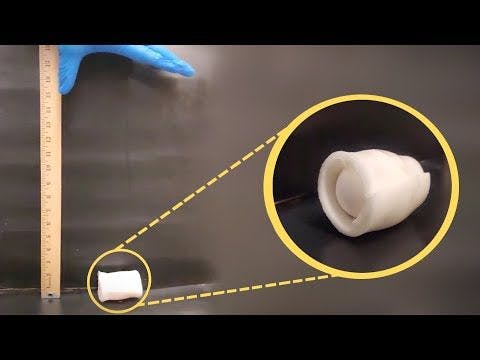Hydrogels are networks of polymer chains that are swollen in water. In recent years, research has focused on making hydrogels that are flexible and bendable. Could this pave the way for an inexpensive, biodegradable packaging material? New research published by ACS explores the possibilities.

This article is based on this recent paper published in ACS Applied Materials & Interfaces, “How a Gel Can Protect an Egg: A Flexible Hydrogel with Embedded Starch Particles Shields Fragile Objects Against Impact”.
Hydrogels are networks of polymer chains that are swollen in water. In recent years, research has focused on making hydrogels that are flexible and bendable. Could this pave the way for an inexpensive, biodegradable packaging material? New research published by ACS explores the possibilities.
Food waste and excess, unsustainable packaging are major environmental issues, and there is a move towards creating novel solutions that could overcome them. In the department of Chemical and Biomolecular Engineering at the University of Maryland, Ganesh and colleagues have contributed to the field of hydrogels by creating gels via either physical or chemical cross-linking, and with the addition of various particulates. A hydrogel is a three-dimensional polymer network that can absorb and retain water. Collagen and gelatin are examples of hydrogels found in nature, and they are already used in many medical settings, but new research is focussed on creating hydrogels with more diverse applications.
The aim of this study was to develop a flexible gel that could be wrapped around brittle or fragile objects to protect against impact. Their report published in ACS Applied Materials & Interfaces explains that none of the bare gels were protective, and the addition of nanoparticles such as iron oxide or silica made no difference. However, the addition of starch granules to a gelatin hydrogel enhanced the protective abilities – with a 25% reduction in peak impact force compared to the same gel without the starch.1 In the study, fragile items such as eggs and blueberries stayed intact when wrapped in a gel infused with starch, even when landing on a hard surface, or if something was dropped on them from above. Overall, gels made with 10% gelatin and 10–20% starch were ideal in terms of their flexibility and impact absorption.
Alongside this impact reduction, the coefficient of restitution – the ratio of the final to initial relative speed between two objects after they collide – was also lowered by the presence of starch. In practical terms, this means that a ball would bounce less on a starch-bearing gel than on a bare gel or a hard surface.
This research may prove instrumental in designing protective coatings for fragile objects –particularly when looking for inexpensive, biodegradable alternatives to traditional bubble wrap and packaging peanuts. There may also be future applications across diverse sectors such as sports and defense, where protecting eggs from impact could be scaled up to protecting heads.
Watch the video around this research created by the ACS Science Communications team:
Read the full press release on acs.org
Read the original article from ACS Applied Materials & Interfaces
Further reading on this topic
Increased Hydrogel Swelling Induced by Absorption of Small Molecules
Changwoo Nam, Tawanda J. Zimudzi, Geoffrey M. Geise, and Michael A. Hickner
DOI: 10.1021/acsami.6b02069
Super Tough, Ultrastretchable Hydrogel with Multistimuli Responsiveness
Meng-Meng Song, Ya-Min Wang, Bing Wang, Xiang-Yong Liang, Zhi-Yi Chang, Bang-Jing Li, and Sheng Zhang
DOI:10.1021/acsami.8b01410
Impact of Elastin-like Protein Temperature Transition on PEG-ELP Hybrid Hydrogel Properties
Edi Meco and Kyle J. Lampe
DOI: 10.1021/acs.biomac.9b00113

